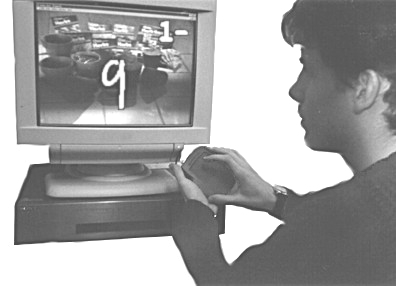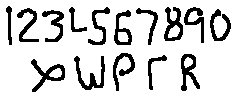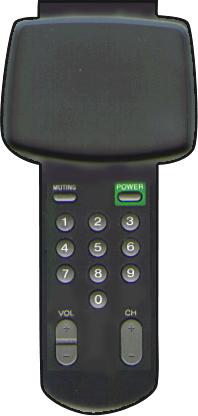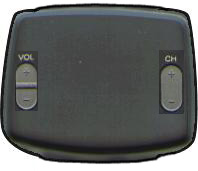Enns, N. R. N., & MacKenzie, I. S. (1998). Touchpad-based remote control devices. Companion Proceedings of the ACM Conference on Human Factors in Computing Systems - CHI '98, pp. 229-230. New York: ACM. [video]
Touchpad-based Remote Control Devices
Neil R. N. Enns1 and I. Scott MacKenzie2
1Department of Computer ScienceUniversity of Toronto
Toronto, ON Canada M5S 3G4
416-978-1531
2Department of Computing and Information Science
University of Guelph
Guelph, ON Canada N1G 2W1
519-824-4120 x8268
Abstract
A new style of remote control device (RCD) that incorporates a touchpad for input is described. Unistrokes created through touch are used to issue commands and select menu items presented on a television screen. The design addresses the drawbacks of traditional RCDs, such as an over-abundance of buttons and the lack of alphanumeric input. We have assembled a prototype using a Windows95-based computer, an infrared card, and a touchpad. Future developments and research plans for the touchpad-based RCD are also discussed. Keywords: Remote control devices, touchpads, television, unistroke recognition, input devices, convergent technologies
Introduction
Remote control devices (RCDs) were introduced in the 1930s, as a mechanism for changing stations on radios. Since then, the popularity and complexity of RCDs has grown dramatically. Today, 97% of North American households own at least one RCD [1], and the current generation of RCDs allows users to control everything from televisions to thermostats. However, the design of RCDs has changed very little since the mid-1970s. Today's units, much like early RCDs, consist of rows of tiny buttons, each with its own tiny label.
This paper introduces a new style of remote control device using a touchpad for input, combined with gesture-based interaction. While touchpads are common in notebook computers, they have yet to be used to address drawbacks in today's RCDs.
Disadvantages of Traditional Remotes
Traditional remote control devices suffer from several disadvantages, including:
Lack of scalability: Adding features to electronic devices usually requires adding buttons to the RCD. The Sony RMT-V5A RCD, for example, has 82 buttons!
Difficulty in supporting new technologies: The integration of home entertainment systems with other services such as personal banking, email, and web browsing is growing in popularity. However, today's RCDs do not support the required interactions (such as text entry, menu selection, and link navigation). It would be useful, for example, if RCDs supported straightforward text entry for keyword searching in a web browser.
"Universal" RCDs (e.g., the Marantz RC2000 [2]) and RCDs with isometric pointing devices (e.g., the Interlink IRC-TC [3]) address some of these disadvantages; however, claims of "user friendly" are, at the very least, suspect. Universal RCDs, for example, often include 100+ buttons. Isometric pointing devices support point-and-click interaction, but accurate cursor positioning is problematic [4].
The Touchpad-Based Remote Control Device
The remote control device described herein addresses the drawbacks of current RCDs through the use of a touchpad. Our goal is to move the interface from the RCD (as embodied in the layout of buttons) and place it on the TV screen. The user's focus of attention remains on the display, rather than switching between the display and the RCD.
Another benefit is scalability: New features are implemented through software, rather than by redesigning the RCD with additional physical devices. A touchpad-based RCD opens the door to new interaction techniques, such as unistroke character recognition [5], marking and pie menus, and soft keyboards. By combining these interactions with a well designed on-screen menu system RCDs can be more flexible and simpler at the same time.
|
|
|
Figure 1: Two design concepts for touchpad-based RCDs
As shown in Figure 1, the touchpad-based RCD doesn't necessarily eliminate buttons altogether. To provide rapid access to the most common RCD commands (such as power, volume, and channel selection), our design concepts incorporate a few carefully selected buttons.
The Prototype
To explore usability aspects of touchpad-based RCDs, we built a prototype system consisting of a Windows95 Pentium computer with an ATI ATI-TV tuner card that displays television signals within application windows. The system also includes a Dancraft IR Jukebox 100S infrared transmitter/receiver to control IR-equipped devices (e.g., VCRs, CD players), a Sony SLV-R5UC VCR, and a Synaptics T1002D touchpad serving as our prototype RCD. We developed a set of C++ classes to control the functionality of the devices, including the ability to:
- Send infrared commands to a VCR
- Manipulate the TV tuner card properties (such as selected channel, brightness, tint, and contrast)
- Read low-level data from the touchpad
- Interpret finger-created unistrokes as characters or commands
We wrote an application to exercise the functionality of the classes. Users can issue the basic TV and VCR commands via unistrokes entered on the touchpad. Figure 2 illustrates a user in the process of switching to channel 19.

Figure 2: Sample touchpad-based RCD
The unistrokes in Figure 3 are presently supported. In addition to the ten digits, our system uses x (stop), w (power), p (play), f (fast forward), and r (rewind).
Advantages of Touch-based Remotes
A touchpad-based remote control device can provide a range of benefits, including:
Simplified physical form: This is a natural result of transferring the interface from the RCD to the display using a touchpad input device. This simplification should make RCDs more inviting to the average user.
Flexible interaction styles: Interaction techniques such as drop-down menus, pie menus, soft keyboards, and unistrokes are supported. These should prove useful with the convergence of computing and television technology.
Reduced manufacturing costs: Currently, when new feature are added to electronic devices, the RCD is re-engineered to support the new features. With touchpad-based RCDs, this is unnecessary: the manufacturer simply updates the software-based menu system. The current proliferation of buttons results in remotes that cost upwards of US$200. Touchpad-based RCDs could be substantially cheaper - touchpad OEM prices are very low, due to their use in the highly competitive notebook computer market.

Figure 3. The Graffiti-like unistrokes supported in our prototype
Future Development and Research Plans
We are planning to expand beyond simple unistroke character recognition. We are exploring the use of interfaces that depend on either a cursor (e.g., point and click) or "hot-spots" (e.g., option grids). Our expanded prototype will support additional television, VCR, and CD player functionality, as well as Internet services.
We also plan to construct a hardware prototype of a touchpad-based RCD (see Figure 1) and to conduct usability studies. These will establish if touchpad-based RCDs, when combined with well-designed interaction styles, are useful and acceptable alternatives to today's button-laden devices.
References
1. Lowry, B. TV viewers seize control. The Toronto Star. (Aug 14, 1997), E10.
2. http://www.marantzamerica.com/rc-2000.htm
3. http://www.interlinkelec.com/
4. Mithal, A.K. and Douglas, S.A. Differences in movement microstructure of the mouse and the finger-controlled isometric joystick. In Proc. CHI '96. New York: ACM, pp. 300-307.
5. Goldberg, D. and Richardson, C. Touch-typing with a stylus. In Proceedings of the INTERCHI '93 Conference on Human Factors in Computing Systems. New York: ACM, pp. 80-87.

